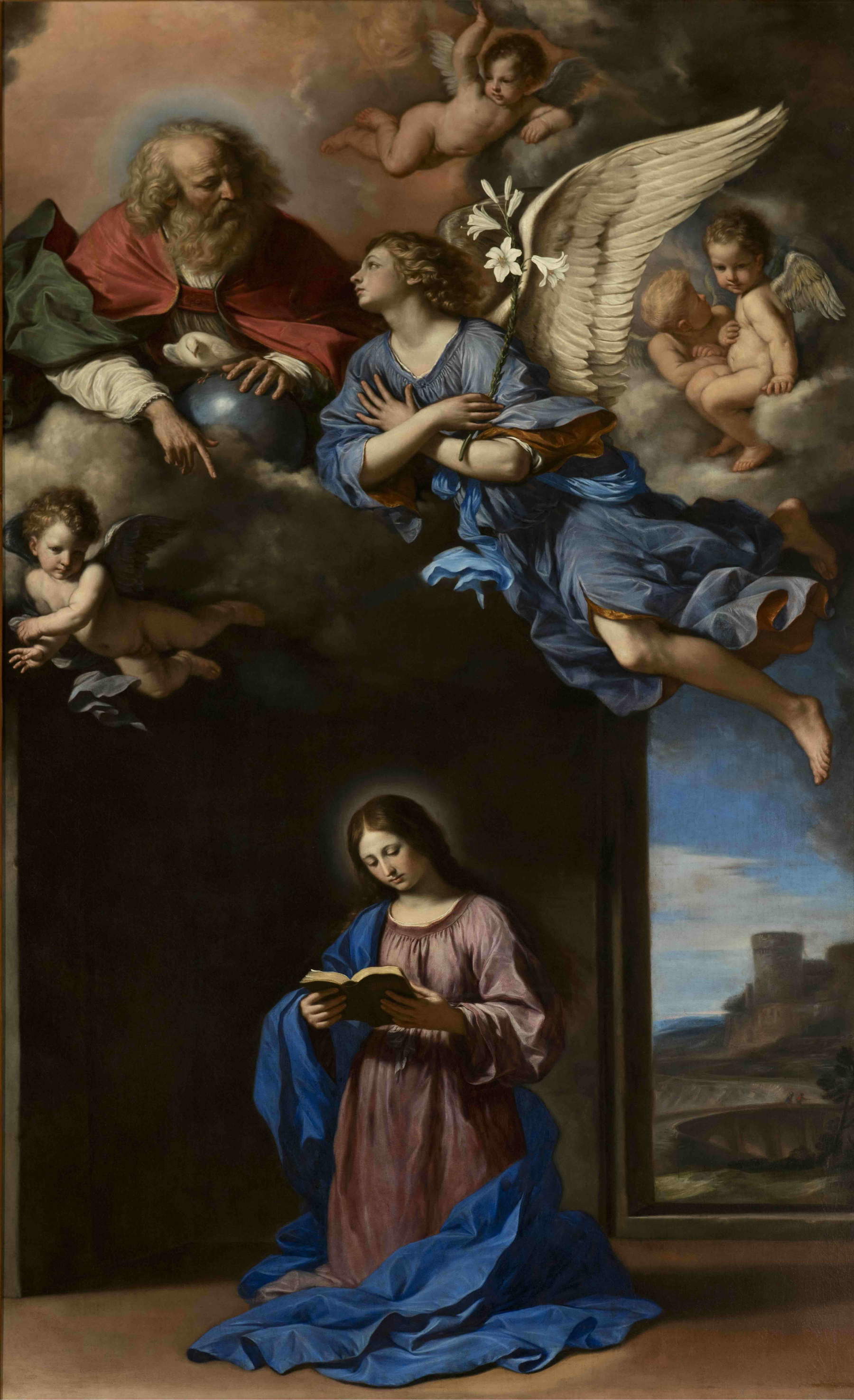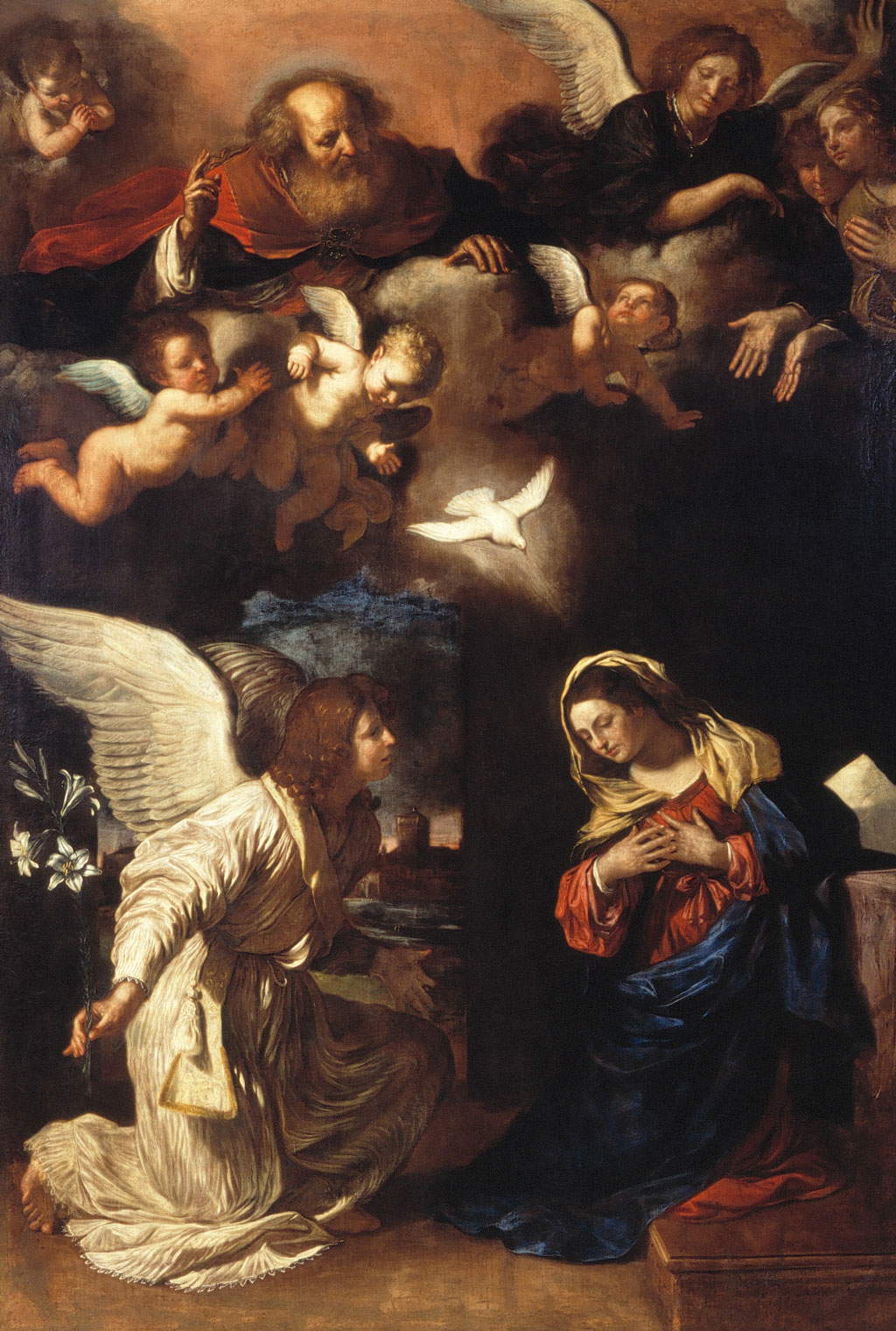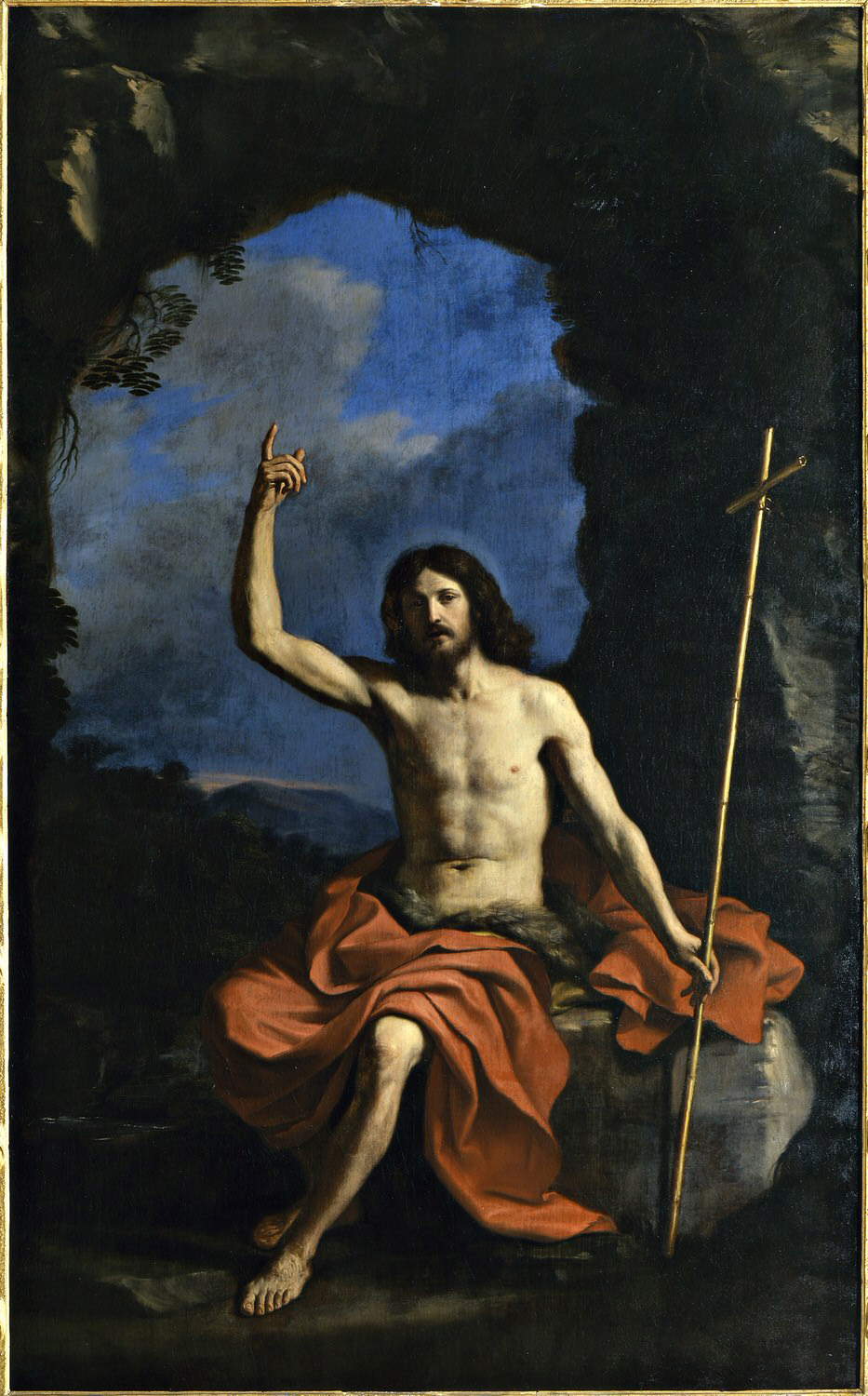The two Forli paintings discussed in this article can be seen at the exhibition Guercino, a New Look, in Cento, Church of San Lorenzo, from Sept. 21, 2024 to Dec. 31, 2025.
During the nineteenth century, at two different times, two of the three large altarpieces that Guercino (Giovanni Francesco Barbieri; Cento, 1591 - Bologna, 1666) painted for churches in the Romagnola city entered the Pinacoteca Civica di Forlì : theAnnunciation and Saint John the Baptist. The former, mentioned for the first time in literature as early as 1657, in Francesco Scannelli’s Microcosmo della pittura , was kept in the church of San Filippo Neri for which it was painted, and here it remained until 1863, when the Corbizzi family sold it to the Municipality of Forlì, which decided to allocate it to the Pinacoteca and to have a copy, executed by the painter Luigi Pompignoli, placed in the church. On the other hand, the Saint John the Baptist, also mentioned in Scannelli’s Microcosm , was located in the church of the Capuchins in Forlì and was the object of the Napoleonic spoliations (the French, it is well known, had a particular passion for Guercino and the Bolognese seventeenth century): removed from its location in 1811, the painting was sent to the Pinacoteca di Brera, and did not return to Forlì until 1816, after which, like other Forlì works that had been removed by the French, it went to form the original nucleus of the Pinacoteca Civica, founded in 1838 and opened to the public in 1846, first in the Palazzo dei Signori della Missione, then moved in 1922 to the Palazzo del Merenda, and finally transferred, in several stages beginning in 1996, to the San Domenico complex: Guercino’s two paintings are among the last works to leave the Palazzo del Merenda to reach their new home.
Both works are documented in the Book of Accounts with which the artist’s workshop kept accounting records of its activity: theAnnunciation was paid, in 1648, 400 ducatsoni by Signora Polissena Corbizzi (who bought it together with a St. Jerome now in a private collection in New York), while for the St. John the Baptist to be destined for the Capuchin church the painter received 135 ducatsoni, partly paid by the Capuchins of Forlì and partly by Marquis Bernardino. The big difference in price from theAnnunciation, despite the almost similar size of the two canvases, lies in the perception of their complexity: as was usual at the time, the price of a work of art varied on the basis of the figures in the composition . The greater the number of figures, the higher the price to be paid: in this sense, theAnnunciation sees the presence of as many as three main figures alongside several putti (the latter also contributed to raising the price, which was indeed high even for a work by Guercino), while in the Saint John the Baptist it is the saint who is the sole protagonist.
Beyond purely economic issues, the two Forli paintings, although perhaps less well known than other Guercino paintings, represent an important junction in the Cento painter’s art, and they are also interesting because they capture a moment of great ferment in his career, a time when theartist, despite his advanced age, showed that he wanted to continue experimenting and looking around, and because they allow us to take a deep dive into the work of the workshop, since these are two works to be placed in close relation to as many paintings found in the territory of Cento and nearby Pieve di Cento: theAnnunciation, in particular, is related to the work of homologous subject that Guercino painted two years earlier for the church of Santissima Annunziata degli Scolopi in Pieve di Cento (today, however, it is in the parish church of Santa Maria Maggiore), while St. John the Baptist is to be read in relation to the painting, again having the same subject, executed in 1650 for the Redolfini chapel in the church of the Rosario in Cento (it is now also in Cento, but in the Pinacoteca Civica).



The period in which Guercino waits to make the two paintings is a singular, unique moment. Between the 1940s and the 1950s, Guercino was one of the most in-demand painters on the market, he was at the height of his career, but he was a painter who did not rest, and continued to try new avenues: thus, works with certain recurring characteristics, summarized by Daniele Benati, in the exhibition catalog Guercino, un nuovo sugardo, make their way into this period . Works from Forlì and Other Hidden Places (Cento, Pinacoteca San Lorenzo, from September 21, 2024), in three basic elements: “compact gravity of the poses,” “elegance of drawing,” and “brilliance of color.” Characteristics to be found also in the Forlì altarpieces, which, although they take up works that the artist had done shortly before, demonstrate, Benati writes, that “Guercino’s inspiration does not diminish, but is enriched with ever new and pregnant expressive solutions.” TheAnnunciation, in particular, is one of the most original paintings of the Emilian painter’s career: for the painting destined for the church of the Scolopi in Pieve di Cento, the artist had elaborated a particular iconography that links two distinct episodes in a single scene. The apparition of the Eternal Father, whom we see appearing in the clouds, was not an invention of Guercino’s: there are many Annunciations in the history of art in which God is seen appearing in the midst of a swirl of clouds. But for Pieve di Cento, Guercino instead felt free to innovate. To seek new solutions. To invent new iconographies. And here, then, comes the extraordinary invention: “In 1646, Guercino,” wrote Denis Mahon in his seminal 1968 monograph on the artist, “had painted for Pieve di Cento an altarpiece depicting the Angel receiving instructions for his mission from the Eternal Father, and the Virgin kneeling below, reading a book [...]. This way of rendering the subject had evidently met with favor, and Guercino received a commission to repeat it for the church of the Oratorians in Forli.”
In the first moment of the scene, the Eternal Father instructs the archangel Gabriel to announce her pregnancy to the Virgin: Gabriel, with outstretched wings, is in flight before God, with his hands crossed on his chest as a sign of reverence (curiously enough, this is the gesture that, on the contrary, it is the Virgin who is used to make in the presence of the angel), and the Eternal Father explicitly points with his hand to Our Lady, looking Gabriel in the eyes, even addressing a few words to him, in a gesture of great spontaneity and naturalness. In the second moment, we see Mary in her home, kneeling to read, still unaware of what will happen to her shortly. “It thus remains silent,” scholar Massimo Pulini has written, “the whole focus of the painting, its spiritual center revolving around the theme of meditation and, to some extent, also of the unconscious human condition. The result is a scene that is not even domestic, so bare, sober, yet in the large painting the description of space remains intimate in its being halfway between interior and exterior. Behind the Virgin’s shoulders a threshold opens, allowing the gaze to drift away into the terse vision of a landscape, in the river valley that immediately meets a wide bridge and then rises toward the profile of a mighty castro. A gateway to the world that seems to allude to a dimension more symbolic than scenic.” Here is Guercino’s invention. No longer a single scene, but a kind of film painted in a single sequence, with two separate moments intertwining. The Eternal Father who no longer observes from above, but becomes the protagonist on a par with the archangel and the Virgin. The divine investiture, the mission to which the Virgin is called made explicit.
This is how Guercino decided to subvert traditional iconography. And it was the second Annunciation of his career: the first, painted around 1638-1639 for the Ospedale Maggiore in Milan, still followed the classical representation, with the moment of the angel’s arrival, the moment of confrontation, that of the announcement. In Pieve di Cento, on the contrary, the artist imagines a scene divided into two parts, an almost cinematic sequence, heartfelt, involving, so much so that in Forlì he was asked, essentially, for a replica. Guercino, however, did not simply recover a model from two years earlier: he wanted to continue to innovate, and to give more movement to the scene, to give a more dramatic and at the same time solemn tone to his Annunciation, he matured the idea of including in the composition the putti that are absent from the altarpiece in Pieve di Cento and appear instead in the one in Forlì. And that the artist had no desire to limit himself to a replica is attested by the drawings that show how much effort Guercino had put into devising variations on the Pieve di Cento painting. Studies with which the artist concentrates mainly on the upper part of the composition, that is, the one most varied from theAnnunciation of Pieve di Cento, sheets traced back to the ideational stages of the painting by Denis Mahon. Instead, the pictorial rendering shows that Guercino did not even intend to entrust the execution of the painting to his collaborators: the figures are in fact painted with care, the passages of light and shadow in the drapery rendered with finesse, the complexions painted with delicacy, and the robes have a tactile texture, with iridescences aimed at suggesting in a concrete way the sheen of silk in accordance with a need for realism that the artist had been dragging along since his youth and that would never cease even in the more advanced stages of his career.


The same can be said for the Saint John the Baptist: here, Guercino does not pose the problem of renewing the patterns of tradition, but nevertheless chooses to offer his patrons, and the faithful who would have seen the work in the church, a composition of sure impact, of monumental scale, with the Baptist leaning against a rock, inside a cave in the midst of nature, silhouetted against a cloud-veiled sky, his arm and ’index finger pointing toward God standing out against the blue, the young saint’s eyes turned toward those of the relative, the same figure of John the Baptist who, to increase the emotional impact, emerges from a skillful backlight that in the Forlì version also appears more dynamic than in the Cento altarpiece, since in the Forlì painting the Baptist is caught in motion. In Forli’s Saint John the Baptist , Guercino is also concerned with renewing what he had done previously. Meanwhile, he greatly rejuvenates the saint, who is no longer the bearded hermit of the Cento altarpiece, but becomes an Apollonian adolescent with a flushed face. And then, the Forli altarpiece acquires a decidedly more scenographic breath, more “baroque,” so to speak, precisely by virtue of the movement that Guercino bestows on the Forlì Baptist, discernible even in the way the crimson veils that cover his nudity encircle his figure, emphasizing his gait, which was not the case in the Cento altarpiece, where the saint is instead quieter, seated on the rock.
Even at these chronological heights, at the threshold of sixty years of age, Guercino thus emerges as an artist who is anything but tired, or prone to repetitiveness, a condition shared by several painters toward the end of their careers. This is not the case for him, despite the fact that the last phase of his career has often been judged as weaker than other periods: “The undoubted quality of this great Forlì altarpiece proves, once again, how much the reservations often advanced against Guercino’s last manner,” writes scholar Giacomo Alberto Calogero, “are not only unjust, but the result of an inveterate prejudice that does not seem to take into account the real pictorial values expressed by the master until late in his career: certainly, the chromatic choices appear increasingly refined, with the use of dazzling backgrounds, shining like rare gems; the atmosphere, no longer brusque and thundering, becomes lighter and calmer, while the drawing tends to become sharper,” an’evolution that can be understood as “the result of a meditated absorption of the more elect classicist taste imposed by Reni and his school,” or as “an understandable attenuation of certain youthful intemperances, no longer felt and seething as they once were.” nonetheless, Guercino was “still capable of giving birth to marvelous ideas and executing them with refined mastery, as precisely happens in the Forlì painting, all played out on the subtle contrast between the shadow cast by the cavernous cavern, the pregnant rain-cloud and the dazzling radiance of the Baptist.”
Finally, one has to wonder how much Guercino was looking around at this stage of his career. These paintings of skies and azure not only seem to look toward certain developments of Reni’s classicism, but also toward the new painting of some young, exuberant followers of Guido Reni who knew how to innovate the master’s painting in a more baroque sense, leveraging the brilliance of colors and dizzying compositions: Guido Cagnacci, Cristoforo Serra, Simone Cantarini. That is to say, artists who were working at leisure in the Romagna of the 1740s, artists who were experimenting, artists who were trying to renew what they had learned from observing or studying the crystalline painting of Guido Reni (sometimes even directly with him: Cantarini was his pupil), giving it the direction of a scenographic Baroque animated by the demands of naturalism and yet not losing that substratum of classical, Raphaelesque imprint that the Bolognese master had imposed on the attention of colleagues and patrons. Benati himself recognizes overlaps between the “new course of Guercino’s painting” and certain works by Cagnacci, such as the “quadroni” in Forlì Cathedral, or certain paintings by Cristoforo Serra: there is no doubt that the two Romagnoli had taken many cues from Guercino’s art (moreover, the three knew each other intimately: Guercino, during the period of study and work spent in Rome, had lived first with Cagnacci and then with Serra), and there is no doubt that for all of them the basis was certain altarpieces by Guido Reni (the Madonna of the Plague in Bologna, for example), but perhaps it cannot be ruled out that the elderly master nurtured some form of admiration for those two exuberant 40-year-olds.
Warning: the translation into English of the original Italian article was created using automatic tools. We undertake to review all articles, but we do not guarantee the total absence of inaccuracies in the translation due to the program. You can find the original by clicking on the ITA button. If you find any mistake,please contact us.